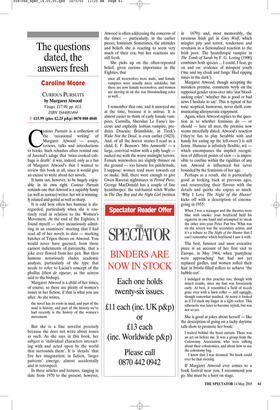The questions dated, the answers fresh
Caroline Moore
CURIOUS PURSUITS by Margaret Atwood Virago, £17.99, pp. 413, ISBN 1844081494 ✆ £15.99 (plus £2.25 p&p) 0870 800 4848 Curious Pursuits is a collection of the ‘occasional writing’ of Margaret Atwood — essays, reviews, talks and introductions to books. Such rehashes often remind one of Juvenal’s adage that ‘twice-cooked cabbage is death’: it was, indeed, only as a fan of Margaret Atwood’s that I wanted to review this book at all, since it would give an excuse to write about her novels.
It turns out, however, to be hugely enjoyable in its own right. Curious Pursuits reminds one that Atwood is a superbly funny (as well as serious) writer: her wit is winningly relaxed and genial as well as sharp.
It is odd how often her humour is disregarded, particularly when she is routinely read in relation to the Women’s Movement. At the end of the Eighties, I found myself — after incautiously admitting in an examiners’ meeting that I had read all of her novels to date — marking batches of Tripos theses on Atwood. You would never have guessed, from those earnest indictments of patriarchy, that a joke ever flowed from her pen. But then humour notoriously eludes academic analysis, particularly of the type that needs to refer to Lacan’s concept of the phallus (then de rigueur, as the actress said to the bishop).
Margaret Atwood is a child of her times, of course; so there are plenty of women’s issues in her fiction, if that is what you are after. As she writes,
the novel has its roots in mud, and part of the mud is history, and part of the history we’ve had recently is the history of the women’s movement.
But she is a fine novelist precisely because she does not write about issues as such. As she says in this book, her subject is ‘individual characters interacting with and acted upon by the world that surrounds them’. It is ‘details’ that fire her imagination; in fiction, ‘larger patterns’ emerge, almost accidentally and in retrospect.
In these articles and lectures, ranging in date from 1970 to the present, however, Atwood is often addressing the concerns of the times — particularly, in the earlier pieces, feminism. Sometimes, the attitudes and beliefs she is reacting to seem very much of their era; but her reactions are still fresh.
She picks up on the often-repeated belief, given curious importance in the Eighties, that
once all werewolves were male, and female vampires were usually mere sidekicks; but there are now female werewolves, and women are moving in on the star bloodsucking roles as well...
in 1879); and, most memorably, the ravenous Irish girl in Grey Wolf, which mingles pity and terror, tenderness and revulsion in a fictionalised reaction to the Irish poor. The lycanthropic vampire in The Tomb of Sarah by F. G. Loring (1900) combines both species ... I could, I fear, go on and on: evidence of misspent youth (‘me and my cloak and fangs/ Had ripping times in the dark’).
Margaret Atwood, though accepting the mistaken premise, comments wryly on the supposed gender cross-over into ‘star bloodsucking roles’: ‘whether this is good or bad news I hesitate to say’. This is typical of her tone: sceptical, humorous, never shrill, communicating idiosyncratic enjoyment.
Again, when Atwood replies to the question as to whether feminists do — or should — hate all men, the premise now seems mercifully dated; Atwood’s reaction (‘they’re fun to play Scrabble with and handy for eating up the left-overs’) is still funny. Humour is infinitely flexible; wit which encompasses the implicit recognition of different points of view — is impossible to confine within the rigidities of any ism. Atwood is influenced but never bounded by the feminism of her age.
Perhaps as a result, she is particularly good at looking back at previous ages, and resurrecting their flavour with the details and quirks she enjoys so much. ‘Why I Love The Night of the Hunter’ kicks off with a description of cinemagoing in 1955: When I was a teenager and the theatres were blue with smoke: your boyfriend held his cigarette in one hand and attempted to sneak the other into your Peter Pan bra. What was on the screen was the secondary action, and it’s a tribute to The Night of the Hunter that I can’t remember which boyfriend I saw it with.
The best, funniest and most evocative piece is an account of her first visit to Europe, in May 1964, when ‘pantyhose were approaching’ but had not yet replaced girdles, and women rolled their hair in bristle-filled rollers to achieve ‘the bubble-cut’.
I indulged in this practice too, though with mixed results, since my hair was ferociously curly. At best, it resembled a field of weeds gone over with a lawn roller — still squiggly, though somewhat mashed. At worst it looked as if I’d stuck my finger in a light socket. This silhouette was later to become stylish, but was not so yet.
She is good at jokes about herself — like the description of going on a tacky daytime talk-show to promote her book.
I waited behind the bead curtain. There was an act on before me. It was a group from the Colostomy Association, who were talking about their colostomies, and about how to use the colostomy bag.
I knew that I was doomed. No book could ever be that riveting.
If Margaret Atwood ever comes to a book festival near you, I recommend you go. She must be a hoot on stage.


































































 Previous page
Previous page